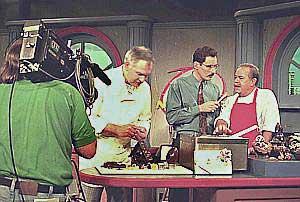Module 68
Updated: 07/12/2005
`
Non-Broadcast
TelevisionAlthough broadcast television is the most visible part of the television business, in terms of personnel, equipment and facilities, non-broadcast production is actually the largest segment of this field.
Included in the category of non-broadcast television is institutional video, which includes corporate, educational,
religious, medical, and governmental applications, and avocational television, which is associated with serious personal/professional applications.
Although the field of institutional video may not be as visible or glamorous as over-the-air broadcasting, average salaries are often higher, job security is better, working hours and conditions are more predictable, and there are often more perks (work associated benefits).
Institutional Video
Institutional video has proven itself in many areas. These include -

Institutional television has been particularly effective in seven areas:
1. where graphic feedback is necessary Seeing something first hand is generally more effective than talking about it. This is particularly true when it comes to feedback on artistic work or athletic performance.
2. where closeups are required to convey information The TV camera can make details and information obvious.
This is especially true in medical television. It's also possible to get cameras into hazardous and hard-to-reach places.
3. where subject matter can best be seen and understood by altering its speed Often, things cannot be clearly seen or understood without the use of slow motion or time-lapse (speeded up) photography.
4. where special effects such as animation can best convey information Animated drawings, flowcharts, and even animated characters can often make concepts clear.
5. when it's necessary to interrelate a variety of diverse elements Television can pull together and interrelate events and objects so the total effect can be understood. As we noted in the section on editing, the selection and sequence of visual elements generates meaning and emotional response.
6. where it's difficult to transport specific personnel to needed locations Through television, experts are readily accessible to viewers in diverse locations.
7. when the same basic information must be repeated to numerous audiences over time It's more cost effective to use personnel to explain information once to TV cameras, and then play the videotape to numerous groups thereafter.
As an example, let's say a company spends $15,000 producing a simple, 60-minute production designed to indoctrinate new employees to the company, its policies, and the various health and retirement plan options. If 3,000 people view the video over a period of 3 years, the cost would be $5.00 per person. This can represent a major savings in cost and manpower, compared to having personnel repeatedly present the information to individuals or small groups over this time period.
Presentation FormatsThere are four basic presentation formats.
Holding Audience AttentionOne of the findings that consistently emerges from studies on effective television programming is the need for variation in sound, visual information, and presentation style.
In commercial television the commercials, themselves, provide change and give viewers regular "intermissions" from program content. Since non-broadcast productions don't have commercials to break things up, change and variation must be introduced in other ways.
Most viewers can't absorb more than eight to ten minutes of straight information at a time. Unless there's a change in pace, content, or presentation style, attention tends to drift.
Avocational VideoWith professional-quality camcorders and editing equipment within the reach of many people, we are seeing a host of avocational applications. Here are a few examples:
- An insurance agent videotapes the contents of insured homes for evidence in case of loss.
- A psychiatrist uses a camcorder to treat anorexia. To help dispel the physical illusions they hold about themselves, he tries to get the patients to see themselves as others see them.
- An animal rights group videotapes graphic evidence of the inhumane treatment of animals. The tape ends up in a network documentary.
- A camp counselor videotapes the daily experiences of a group of scouts and sells the videotapes to
parents.
Here are examples on a more personal level.
- A homeowner videotapes the contents and personal belongings in his home to have as a record, in case of fire, theft, or natural disaster.
- A dying man records a complete will on videotape, talking personally to each person named.
- A family member records the embarrassing and dangerous antics of another family member who is regularly under the influence of alcohol. Mortified at seeing it, the person seeks treatment.
- By videotaping herself as if talking to a trusted friend, a young woman is able to more fully articulate fears and yearnings. When the tape is played back after a period of time, she is able to more objectively view her feelings and fears.
- An organization puts together a videotape explaining the advantages of building a cultural arts center and presents it to the city council.
- An animal lover videotapes inhumane conditions at a local animal shelter and shows the tape on a local cable channel. The public is outraged, and action is taken to correct the situation.
- Parents interview students about gang-related fears and play the tape in front of the school board. The school board decides to take some action.
Many of the points in this module suggest careers in this field, and this is the topic of the next module.
TO NEXT MODULE Search Site Video Projects Revision Information
Issues Forum Comment or Problem Associated Readings Bibliography
Index for Modules To Home Page Tell a Friend Tests/Crosswords/Matching
